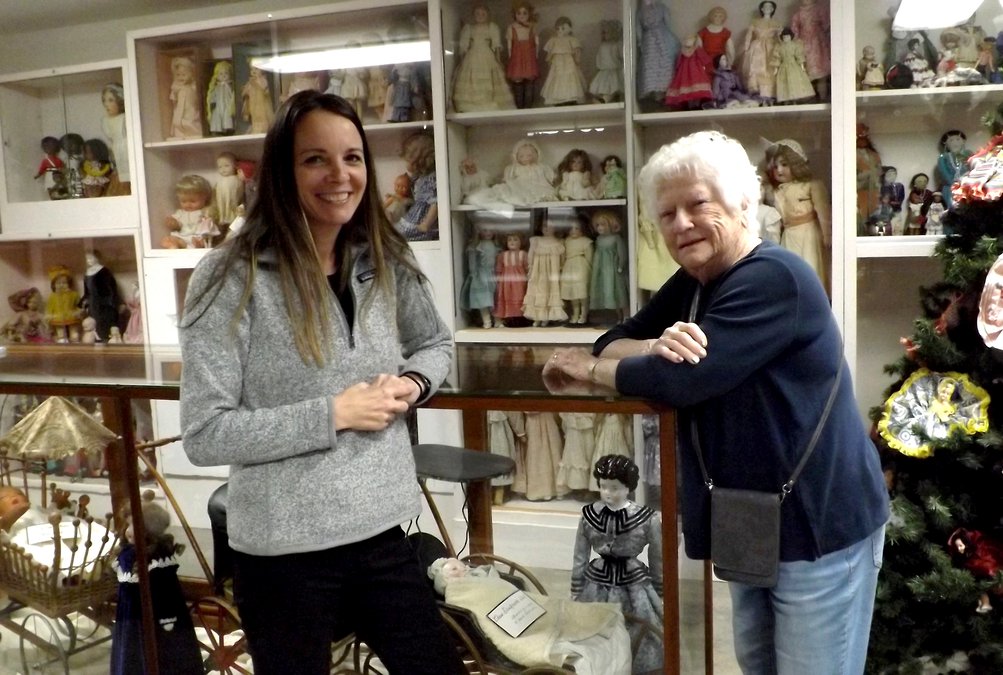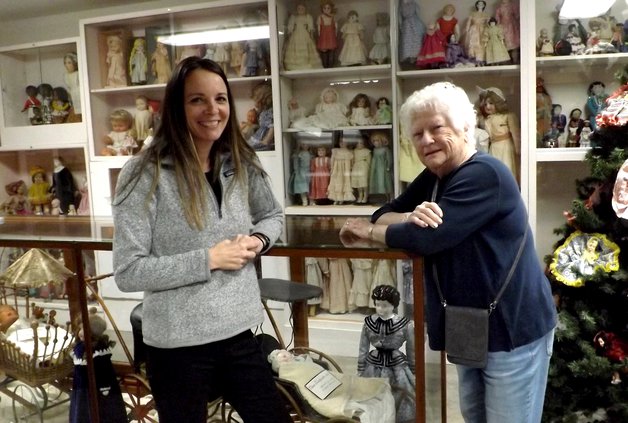My fond hope is that the museum will continue to grow and tell the story of central Kansas as accurately as we know how to tell it.Beverly Komarek
The new director of the Barton County Historical Society Museum and Village is expected to bring new ideas to the storied attraction. But before looking to the future, Tina Mingenback is getting a crash course on the past.
The museum is located on five acres just south of Great Bend on U.S. 281 and includes several buildings filled with artifacts and documents that tell the story of Barton County. The narrative runs from the pre-Columbian era when Native Americans hunted at Cheyenne Bottoms to the history of the Santa Fe Trail and later the railroads. It continues through two World Wars and beyond, to recent history.
Beverly Komarek, who recently retired as executive director of the museum, had more than 20 years to become familiar with the contents of each building and the stories behind them. Mingenback was named as her replacement at the end of November and started on Dec. 4. Since then, Komarek and others at the museum have been immersing Mingenback in the deep history preserved there.
Friday was Komarek’s last day at the museum but she expects she’ll continue to assist with the transition. It reminds her of sending her daughter off to college and telling her, “You have to be your own mother.” For years, Komarek has been telling historical society members and civic organizations that a new generation must step up to preserve the history at the museum as well as the historic monuments and buildings throughout the county.
Paul Maneth, president of the historical society’s board of directors, may have had that in mind back in October when he appointed a search committee to find Komarek’s successor. The board interviewed seven people.
“Everybody was given a fair chance,” he said.
“I was very impressed with (Mingenback) as I visited with her,” Maneth continued. “Tina has a lot of energy and will be on the go in the community.”
Komarek has been involved in many local initiatives over the years and learned a lot about the museum business along the way, Maneth said. “She has a great love for Barton County.”
When seeking the next director, Maneth said the board looked for someone with good administration skills and community participation.
“We wanted a person who has vision about a nonprofit agency that serves Barton County,” Maneth said. The next executive director would be tasked with fundraising as well as creating and implementing changes to attract more people in the community and statewide to the attraction.
A recent grant from the Dorothy M. Morrison Foundation will help. The endowed grant, for an undisclosed amount, will eventually help pay for the executive director’s salary, benefits and continuing education. It was established through the Golden Belt Community Foundation and announced at the end of November.
The museum also receives money from Barton County but relies strongly on historical society memberships, donations and grants, Maneth said. Most of the work is done by volunteers, including board members. Paid staff include Karen Neuforth, BCHS research coordinator, and Leslie Helsel, office manager. There is also a part-time maintenance position.


Tina Mingenback
Mingenback graduated from Ottawa University and then moved to Great Bend, the hometown of her husband Andrew. They have a daughter, Alyvia.
Her father-in-law, Mark Mingenback, was a hospital recruiter for Central Kansas Medical Center. Tina recalls doing volunteer work there in the past and helping with fundraisers for the cancer center. She later managed the Payless Shoe store, then worked for My Town for five years. She became the dietary manager at Cherry Village nursing home and earned dietary certification. More recently she was named the dietary services manager at ElderCare Inc., which has a 28-county territory. She continues to work for ElderCare through the transition as museum director.
“I know the importance of our community support for our nonprofits,” Mingenback said, noting that is one of the strengths she brings to her new job. She admits she has a lot to learn about the contents of the museum and village. “I’ve (been given) tours of half of the buildings,” she said Friday.
Her goal is to bring new ideas to the historical society. “I hope we can get the younger community members involved and continue growing our membership.” Whether that takes the form of more weekend activities or something else is too early to say. On Friday, her staff was ready to take her on a tour of another building at the village.
Beverly Komarek
Komarek served as the executive director for 23 years, but her involvement with the museum started earlier than that. She and her late husband Don moved back to Great Bend in the 1970s and they soon became involved in the historical society.
“I’m a native of Great Bend and Don was a native of Ellinwood,” she said. “My husband was a history major and I hated history,” she recalled. It was his idea to get involved in the historical society. Back then, everything was done by volunteers. The Barton County Historical Society Museum and Village began in 1964 on land donated by the Charles Hulme Estate. It includes historic buildings such as a church, one-room schoolhouse, post office and railroad depot, along with newer buildings added to house antique farm equipment and other large artifacts. The main museum building was constructed in four phases, and Komarek was the director for the last two: a 1999 addition and the Ray Schulz Research Library, added in 2006.
She’s also stayed involved in the community outside of the museum. She is a member of Great Bend’s League of Women Voters and a past president of the Kansas League of Women Voters.
Komarek is proud of the latest historic building added to the village, a 1950s Lustron Home filled with period furnishings. Lustrons were constructed of metal panels and were touted as a modern advancement in post-World War II housing, although the company was short-lived. The house at the museum was disassembled and reassembled, piece by piece, in 2005 and 2006 after being donated in memory of Marion and Edith Weeks. Today, it is the only Lustron house that is open to the public for tours.
“You cannot go anyplace else in the United States of America and walk into a Lustron House,” she said, adding there are still several privately owned Lustron Houses in Great Bend.
Other accomplishments completed by the historical society, sometimes in conjunction with other groups, during Komarek’s tenure include:
• South Hoisington oral history project
• Cheyenne Bottoms initiative
• The B-29 Memorial and history of the Great Bend Army Air Base
• Restoring “The Rifleman” statue north of the Barton County Courthouse
“The history of central Kansas is a fascinating thing,” Komarek said. “We have tried to build that history and tell that history better.”
For example, new discoveries are being made about the early Native Americans in Kansas. Less than two years ago, a Wichita archaeologist announced he had found the lost city of Etzanoa, home to ancestors of today’s Wichita Nation, in the vicinity of Arkansas City. That archeologist, Wichita State University Professor Donald Blakeslee, visited the Barton County museum this year and examined some of its artifacts from Cheyenne Bottoms. There are arrowheads and photos of petroglyphs on sandstone outcrops that are probably 10,000 years old.
The European-American settlers came later because they wanted to own land, Komarek said. Much later, in World War II, the B-29 bomber crews trained at the Great Bend Army Air Base and helped win the war.
Komarek’s tenure as executive director official ended Friday. The board asked for a two-week overlap during the transition to a new director. She has no immediate plans for the future.
“My fond hope is that the museum will continue to grow and tell the story of central Kansas as accurately as we know how to tell it,” she said.





